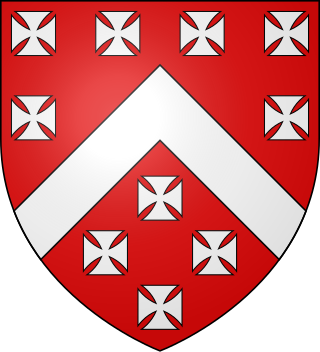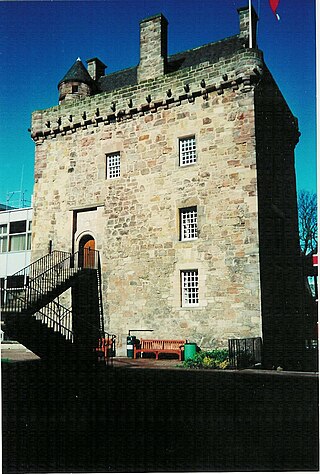
Baron is a rank of nobility or title of honour, often hereditary, in various European countries, either current or historical. The female equivalent is baroness. Typically, the title denotes an aristocrat who ranks higher than a lord or knight, but lower than a viscount or count. Often, barons hold their fief – their lands and income – directly from the monarch. Barons are less often the vassals of other nobles. In many kingdoms, they were entitled to wear a smaller form of a crown called a coronet.

Greenock is a town in Inverclyde, Scotland, located in the west central Lowlands of Scotland. The town is currently the administrative centre of Inverclyde Council. It is a former burgh within the historic county of Renfrewshire, and forms part of a contiguous urban area with Gourock to the west and Port Glasgow to the east.
Earl of Eglinton is a title in the Peerage of Scotland. It was created by James IV of Scotland in 1507 for Hugh Montgomerie, 3rd Lord Montgomerie.

Baron Clinton is a title in the Peerage of England. Created in 1298 for Sir John de Clinton, it is the seventh-oldest barony in England.

Baron Willoughby de Eresby is a title in the Peerage of England. It was created in 1313 for Robert de Willoughby. Since 1983, the title has been held by Jane Heathcote-Drummond-Willoughby, 28th Baroness Willoughby de Eresby.

The title Baron Berkeley originated as a feudal title and was subsequently created twice in the Peerage of England by writ. It was first granted by writ to Thomas de Berkeley, 1st Baron Berkeley (1245–1321), 6th feudal Baron Berkeley, in 1295, but the title of that creation became extinct at the death of his great-great-grandson, the fifth Baron by writ, when no male heirs to the barony by writ remained, although the feudal barony continued. The next creation by writ was in 1421, for the last baron's nephew and heir James Berkeley. His son and successor William was created Viscount Berkeley in 1481, Earl of Nottingham in 1483, and Marquess of Berkeley in 1488. He had no surviving male issue, so the Marquessate and his other non-inherited titles became extinct on his death in 1491, whilst the barony passed de jure to his younger brother Maurice. However, William had disinherited Maurice because he considered him to have brought shame on the noble House of Berkeley by marrying beneath his status to Isabel, daughter of Philip Mead of Wraxhall, an Alderman and Mayor of Bristol. Instead, he bequeathed the castle, lands and lordships comprising the Barony of Berkeley to King Henry VII and his heirs male, failing which to descend to William's own rightful heirs. Thus on the death of King Edward VI in 1553, Henry VII's unmarried grandson, the Berkeley inheritance returned to the family. Therefore, Maurice and his descendants from 1492 to 1553 were de jure barons only, until the return of the title to the senior heir Henry, becoming de facto 7th Baron in 1553. Upon his death he was succeeded by his relative George Harding.

Edward Turnour, 6th Earl Winterton, PC, styled Viscount Turnour until 1907, was an Irish peer and British politician who served as a Member of Parliament for 47 years, attaining the rare distinction of serving as both Baby of the House and Father of the House at the opposite ends of his career in the House of Commons.

In Scotland, the Baronage refers to the class of barons and baronesses who are the heads of their respective baronies. Also known as prescriptive baronies, they used to be attached to a particular piece of land on which was situated the caput or essence of the barony, normally a building, such as a castle or manor house. Accordingly, the owner of the piece of land containing the caput was called a baron or baroness. According to Grant, there were around 350 identifiable local baronies in Scotland by the early fifteenth century and these could mostly be mapped against local parish boundaries.

Lauriston Castle is a 16th-century tower house with 19th-century extensions overlooking the Firth of Forth, in Edinburgh, Scotland. It lies on Cramond Road South, between Cramond, Davidson's Mains, and Silverknowes. The substantial grounds, Lauriston Castle Gardens, operate as a local park. The castle was bequeathed to the Edinburgh Corporation and hosts the Lord Provost's annual Garden Party. The house is a Category A listed building and the grounds are included in the Inventory of Gardens and Designed Landscapes in Scotland.

Clan Colville is a Lowland Scottish clan.

The title Baron Multon de/of Egremont was created once in the Peerage of England. On 6 February 1299 Thomas de Multon was summoned to Parliament. On the death of the second baron, the barony fell into abeyance in 1334.
Richard Fiennes, 7th Baron Dacrejure uxoris was an English politician and hereditary keeper of Herstmonceux Castle in Sussex.

Easter Greenock Castle was a castle of unknown design near the burgh of Greenock, Scotland.
The lands of Finnart to the west of Greenock belonged to the Earl of Douglas in medieval times. Around 1455 they were forfeited to the crown. Finnart was given to the Hamiltons, while the western part of the barony of Finnart went to Stewart of Castlemilk and became the barony of Finnart-Stewart, or Gourock.

The remains of the old castle of Kersland lie about 1.5 miles to the north-east of the town of Dalry in North Ayrshire, Scotland, in the old Barony of Kersland. The River Garnock lies nearby.

Baron of Glengarnock is a title of nobility in the Baronage of Scotland in the county of Ayrshire.

The Old West Kirk of the Church of Scotland, authorised by a 1589 Royal Charter and first opened in 1591, is noted as the first Presbyterian church built in Scotland following the Scottish Reformation, and the first approved by the Parliament of Scotland. At an early stage, east and west aisles were added as transepts, giving the church its cruciform plan.
Baron of Fulwood & Direlton and Lord of Fulwood are nobility titles in the Baronage of Scotland.

Sir Alexander Napier, Lord Laurieston was a 17th-century Scottish landowner, judge and Senator of the College of Justice. He was half-brother of the mathematician John Napier.














